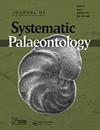两竹状temnospondyls的系统发育:成虫、幼虫和新构造已知分类群的关系
IF 2.2
2区 地球科学
Q3 EVOLUTIONARY BIOLOGY
引用次数: 1
摘要
两栖纲,来自晚古生代岩石的小型temnospondyls,越来越多地被认为是一些或所有现存两栖动物(Lissamphibia)的茎群。在发现新的分类群和修改鲜为人知的分类群后,人们对它们之间的关系进行了深入的研究,但由于两栖纲分为两个非常不同的类群,人们的理解受到了阻碍:(a)仅由成虫已知的陆地分类群(两栖纲、微目)和(b)幼虫和新成虫已知的水生分类群(分支龙科)。分支龙科被认为是一个由一系列幼虫突触形态支持的分支,但陆地分支的未知幼虫形态使一些分支龙科的变形是否可能分布更广泛的问题悬而未决。最近,来自捷克共和国的一些分支龙类标本被认为是olsoniforms和两栖纲的幼虫,加上美国和法国对古代分支龙类分类群的修订,促使人们重新分析这一问题。在对48个分类群和113个特征的系统发育分析中,分支龙科被发现是单系的,与两栖纲和Lissamphibia的假定亲缘关系处于未解决的三分法中。目前的分析发现,假设来自Nýřany的olsoniform幼虫是蝾螈分支龙的成虫,而来自美国伊利诺伊州马松溪的一些幼虫不是分支龙,而是大两栖类的未成熟标本。在分支龙科中,已经确定了四个分支:(a)石炭纪的Anthracobamus分支(Anthracobamus,Montceaubatrachus),(b)主要是石炭纪分支龙亚科(Branchiosaurus,Milnererpeton)和两个主要是二叠纪的分支,即新定义的Apateoniae(Apateon属)和Leptorphinae(Melanerpeton,Leptorphus,Schoenfelderpeton)分支。分支龙的进化涉及到一种增强的幼年形态、鳃齿的改变以及鳞片和胸带中骨骼的连续减少的趋势。本文章由计算机程序翻译,如有差异,请以英文原文为准。
Phylogeny of the amphibamiform temnospondyls: the relationship of taxa known by adults, larvae and neotenes
The Amphibamiformes, small temnospondyls from late Palaeozoic rocks, have been increasingly considered as the stem-group of some or all extant amphibians (Lissamphibia). Their relationships have become intensely studied after the discovery of new taxa and the revision of poorly known ones, but understanding is hampered by the fact that amphibamiforms fall into two very distinct groups: (a) terrestrial taxa known by adults only (Amphibamidae, Micropholidae) and (b) aquatic taxa known by larvae and neotenic adults (Branchiosauridae). The Branchiosauridae were recognized as a clade supported by a suite of larval synapomorphies, but the unknown larval morphology of the terrestrial clades leaves the question open to whether some branchiosaurid apomorphies might have been more widely distributed. Recently, some branchiosaurid specimens from Nýřany (Czech Republic) were proposed to be larvae of olsoniforms and amphibamids, and together with a revision of ancient branchiosaurid-like taxa from the United States and France prompt a re-analysis of this issue. In a phylogenetic analysis of 48 taxa and 113 characters, the Branchiosauridae were found to be monophyletic and nest in an unresolved trichotomy with Amphibamidae and the putative relatives of Lissamphibia. The present analysis finds the hypothesized olsoniform larvae from Nýřany to be adults of Branchiosaurus salamandroides, whereas some of the larvae from Mazon Creek (Illinois, USA) are not branchiosaurids, but immature specimens of the amphibamid Amphibamus grandiceps. Within branchiosaurids, four clades have been identified: (a) the Carboniferous Anthracobamus clade (Anthracobamus, Montceaubatrachus), (b) the mostly Carboniferous Branchiosaurinae (Branchiosaurus, Milnererpeton) and two largely Permian clades, the newly defined Apateoninae (genus Apateon) and Leptorophinae (Melanerpeton, Leptorophus, Schoenfelderpeton) clade. Branchiosaurid evolution involved a trend towards an enhanced paedomorphosis, a modification of branchial teeth, and successive reduction of bone in the scales and pectoral girdle.
求助全文
通过发布文献求助,成功后即可免费获取论文全文。
去求助
来源期刊
CiteScore
5.30
自引率
7.70%
发文量
31
审稿时长
>12 weeks
期刊介绍:
The Journal of Systematic Palaeontology publishes papers that provide novel and impactful results in phylogenetics and systematics and that use these results in ways that significantly advance rigorous analyses of palaeogeography, palaeobiology, functional morphology, palaeoecology or biostratigraphy. Papers dealing with theoretical issues or molecular phylogenetics are also considered if they are of relevance to palaeo-systematists. Contributions that include substantial anatomical descriptions, descriptions of new taxa or taxonomic revisions are welcome, but must also include a substantial systematics component, such as a new phylogeny or a revised higher-level classification. Papers dealing primarily with alpha-taxonomic descriptions, the presentation of new faunal/floristic records or minor revisions to species- or genus-level classifications do not fall within the remit of the journal.

 求助内容:
求助内容: 应助结果提醒方式:
应助结果提醒方式:


